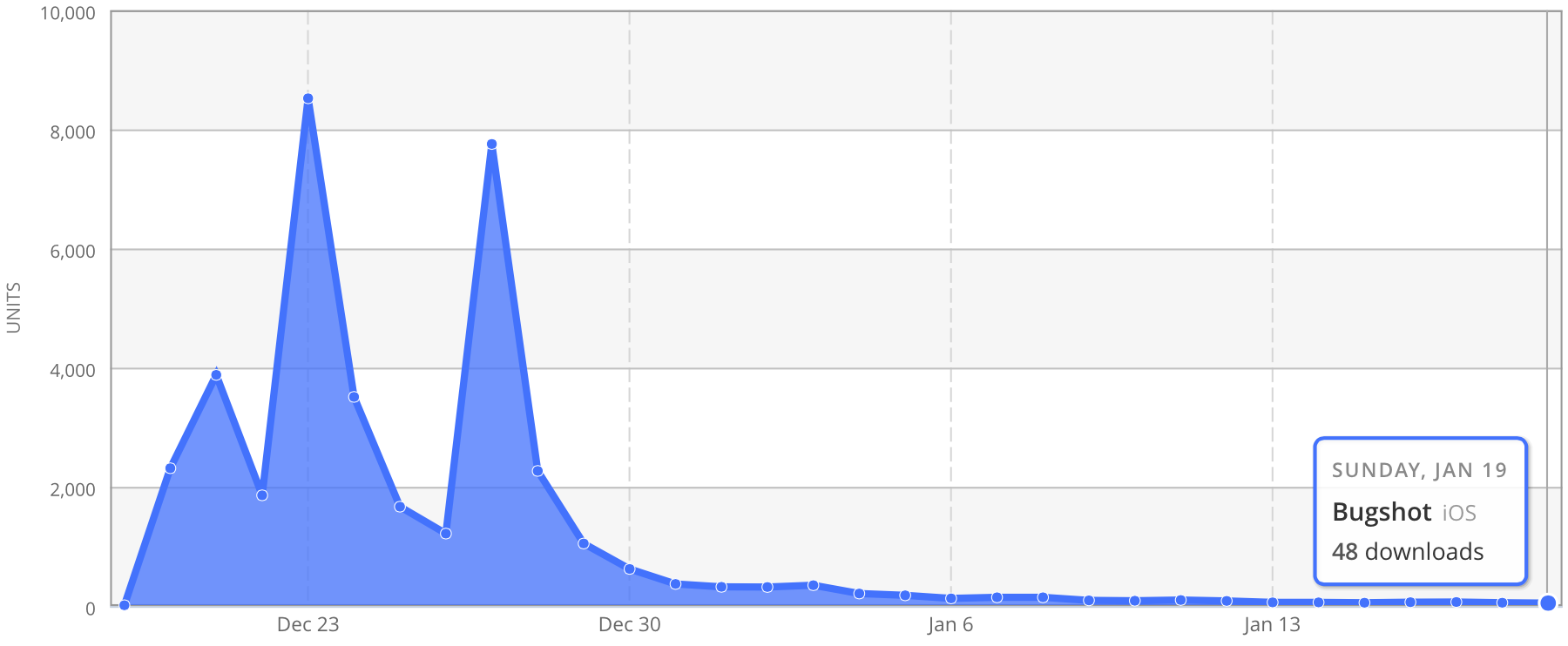BugshotKit
Last summer, I spent about two weeks writing a little app called Bugshot to help me report and track app rendering bugs during the iOS 7 transition, learn the iOS 7 style a bit myself, and jump-start my iOS development motivation again after losing my soul to paperwork all spring. It succeeded at all of those.
It was also an experiment in pricing: I launched it at $0.99 — my first app ever at that price — to see how it would sell once the launch buzz died down. It was abysmal. Average daily revenue in November was $4.18, and in the first half of December, it had fallen to just $3.28.1
As a money-maker, it was a failure, but it was very educational. I decided to learn one more lesson from it: a month ago, right before the iTunes Connect holiday shutdown, I quietly made it free and didn’t tell anyone. Some of the app-tracker sites picked it up, which caused a huge spike in downloads:

But like all App Store trend lines, it quickly went down, settling at around 50 downloads per day recently, and I bet it will continue to fall.
Now I’m taking the Bugshot experiment in a different direction: open source.
I didn’t want to just open-source the entire app. That may be slightly educational to some, but it wouldn’t be very useful.
Instead, I’ve taken the last few days to build BugshotKit.
I’m starting the Overcast beta soon,2 and I wanted an easy way for my testers to report (non-crash) bugs and provide UI feedback. I also wanted a way to remind myself of UI or feature ideas easily, and I’ve occasionally needed to view the error console on the device when tracking down difficult bugs.
BugshotKit addresses all of these: it’s an embeddable Bugshot annotation interface and console logger, invoked anywhere in your app by an otherwise unused gesture (e.g. a two-finger swipe up, a three-finger double-tap, pulling out from the right screen edge, etc.), that lets you or your testers quickly email you with helpful details, screenshots, and diagnostic information.
The GitHub page has more about it if you’re interested.
It contains most of the interesting Bugshot code,3 some interesting console stuff, and some useful functionality to developers.
I’ve learned a lot from Bugshot, and I’m still learning from it. Now, I hope I can share some of the benefits with other developers.
-
From its launch in July until I made it free in December, Bugshot made a total of $4,724.67. This was heavily front-loaded, making $4,088.11 in July and August alone. ↩︎
-
I’ve never had so many requests to be on a beta before. I appreciate the interest, but I’ve gotten far more requests than the 100-device limit. ↩︎
-
I’ve changed the blur tool from a “pixelate” style to a real blur because the pixelate filter used GPUImage, which, despite being awesome, is a massive dependency. I didn’t want BugshotKit to have any dependencies. ↩︎